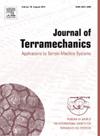微重力作用下松散土动力侵彻起落架的力学特性
IF 3.7
3区 工程技术
Q3 ENGINEERING, ENVIRONMENTAL
引用次数: 0
摘要
月球和行星探测的安全性取决于对覆盖天体表面的由风化层组成的松散土壤与航天器起落架之间相互作用的初步评估,应根据评估结果设计起落架。然而,考虑到与复制地球上天体表层相关的问题,齿轮设计的验证可能具有挑战性。在大型航天器的设计验证过程中,进行实际尺寸的低重力试验仍然是繁琐且资源密集的。因此,从比例模型测试中获取有价值的知识是唯一可行的解决方案。本文介绍了在微重力条件下,利用落塔在一个有比例的着陆平台上进行的动态侵彻试验的结果和发现。实验结果表明,模拟平台动态侵彻风化层的结果并不一定代表低重力条件下的最坏情况,而是与地球重力环境下的结果相当。这一发现表明,通过使用全尺寸航天器模型进行测试,设计验证可能是可行的。本文章由计算机程序翻译,如有差异,请以英文原文为准。
Mechanical properties of loose soil during dynamic penetration of landing pad under microgravity
The safety of lunar and planetary exploration is contingent upon a preliminary assessment of the interaction between loose soils composed of regolith that covers a celestial surface and the landing gear of spacecraft, which should be designed in accordance with the findings of the assessment. However, given the issues associated with replicating the surface layer of celestial bodies on Earth, the verification of the gear design can be challenging. Conducting a real-size low-gravity test in the design verification process of a large spacecraft remains cumbersome and resource intensive. As such, drawing valuable knowledge from scale model tests is the only available solution. This paper presents the results and findings of a dynamic penetration test conducted on a scaled landing pad under microgravity using a drop tower. The experimental findings demonstrate that the results of the dynamic penetration of the pad into the regolith simulant are not necessarily indicative of the worst-case scenario of low-gravity conditions and that they are equivalent to the results obtained in the gravitational environment of the earth. This finding suggests that design verification may be feasible through tests using a full-scale spacecraft model.
求助全文
通过发布文献求助,成功后即可免费获取论文全文。
去求助
来源期刊

Journal of Terramechanics
工程技术-工程:环境
CiteScore
5.90
自引率
8.30%
发文量
33
审稿时长
15.3 weeks
期刊介绍:
The Journal of Terramechanics is primarily devoted to scientific articles concerned with research, design, and equipment utilization in the field of terramechanics.
The Journal of Terramechanics is the leading international journal serving the multidisciplinary global off-road vehicle and soil working machinery industries, and related user community, governmental agencies and universities.
The Journal of Terramechanics provides a forum for those involved in research, development, design, innovation, testing, application and utilization of off-road vehicles and soil working machinery, and their sub-systems and components. The Journal presents a cross-section of technical papers, reviews, comments and discussions, and serves as a medium for recording recent progress in the field.
 求助内容:
求助内容: 应助结果提醒方式:
应助结果提醒方式:


